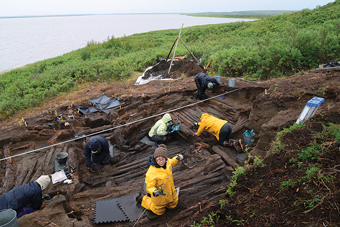When Max Friesen, a professor of anthropology, arrived at an excavation dig alongside the Mackenzie River this past June, he was stepping into a rich history that was literally eroding before him. An arctic archaeologist, Prof. Friesen had travelled hundreds of kilometres north of the Arctic Circle to explore Kuukpak, a centuries-abandoned settlement whose frozen secrets could alter our understanding of Canada’s polar peoples – if erosion due to global warming doesn’t swallow those secrets first. The summer’s excavation yielded an impressive find: Friesen’s 10-member research team discovered a perfectly preserved, five-by-seven-metre cruciform pit house that’s about 400 years old.
Cruciform is a “southern” (by which Friesen means below the Arctic Circle) descriptor for a semi-subterranean arctic residence that the western Inuit’s (the Inuvialuit’s) ancestors built from the abundant driftwood logs on the Mackenzie River, using animal skins and sod for roof insulation. The term “cruciform” does not describe the shape of a religious symbol – rather it describes the overall layout of the house, which, when seen from above, is in the shape of a cross. A tunnel from the entrance leads to a square central floor, with side and forward branches into three alcoves. Typically symmetrical, each alcove would house one family, or more; tight-knit, to be sure.
The Kuukpak cruciform is not unique for being well preserved. (Permafrost prevents the kind of decay common to archaeology sites elsewhere in the world.) However, it is one of the biggest ever discovered, as well as the first to feature a larger, asymmetrical rear alcove, which Friesen speculates may have been used by a more influential family – “maybe the lead hunter.” It’s also the first house to be completely excavated using modern methods. Until now, nobody knew exactly what the originals looked like, or how they were built, says Friesen. “Nobody since the 19th century has seen these houses.”
Friesen’s team is currently examining material discovered inside the cruciform house – traded goods and indicators of wealth and status such as ivory, soapstone and native copper – to see if the larger alcove at the back held more. If it did, it could change our understanding of hierarchy within arctic communities.
Friesen, whose Kuukpak excavation is co-organized by the Inuvialuit Cultural Resource Centre in Inuvik, will return to the dig next year. Time is of the essence. As the Beaufort Sea rises, erosion along the Mackenzie River is an unstoppable, ever-swelling threat. In fact, due to warming, the entire pan-arctic region’s cultural history stands at risk, says Friesen. This project and Friesen’s overall mission, then, is to preserve aspects of history that will otherwise be destroyed. His research has become a matter of prioritizing: making difficult decisions as to which sites merit saving, or even just documenting, while time permits. The payoff, he says, is significant: unique insight into “a major, beautifully preserved cultural history that we really don’t know enough about.”
Recent Posts
U of T’s 197th Birthday Quiz
Test your knowledge of all things U of T in honour of the university’s 197th anniversary on March 15!
Are Cold Plunges Good for You?
Research suggests they are, in three ways
Work Has Changed. So Have the Qualities of Good Leadership
Rapid shifts in everything from technology to employee expectations are pressuring leaders to constantly adapt






One Response to “ The North’s Vanishing Past ”
In writing about archeology professor Max Friesen’s Arctic research, Gary Butler states that “erosion due to global warming” “as the Beaufort Sea rises” is threatening to “swallow” the archeological record – so much so that “the entire pan-arctic region’s cultural history stands at risk” and “time is of the essence.”
First, weather station data in nearby Tuktoyaktuk indicate that over the last few decades, air temperature has not increased and neither has storminess, apparently. Over most of the Arctic, relative sea level has been going down, not up, because of post-glacial isostatic rebound. The Mackenzie Delta, however, is subsiding ever so gently because of the weight of sediment. So, channel erosion is likely the main threat to the site, and it has nothing to with putative climate – or weather – variation over short time scales.
Brian Pratt
PhD 1989
Saskatoon